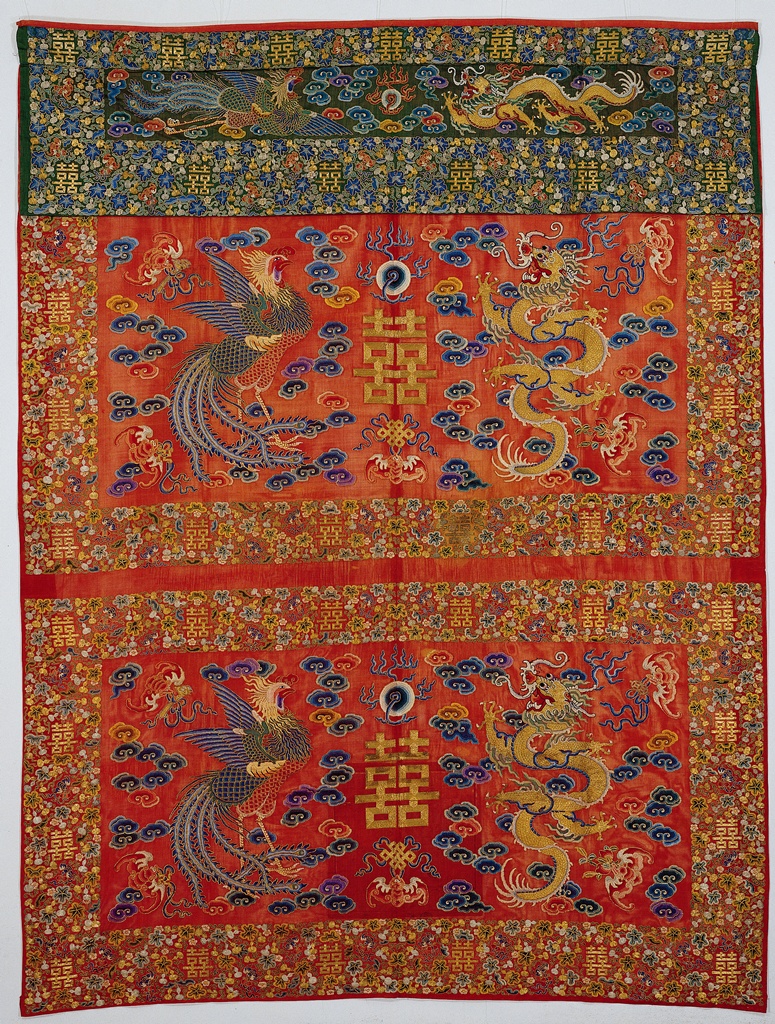- 글번호
- 152757
- 작성일
- 2019.03.02
- 수정일
- 2022.11.03
- 작성자
- 총관리자
- 조회수
- 1202
Wedding Banner Woven Pheonix and Dragon Design

Wedding Banner Woven Pheonix and Dragon Design
Chinese Qing dynasty
186cm(W) x 246cm(L)
Banners were draped on walls close to the ceiling to keep the room warm and control or block light, while it can help protect privacy when hung near the bed or window. In Korea, it was the period of the Three Kingdoms when people began to use banners. According to the housing regulations mentioned in 『The Chronicles of the Three States』, apart from the royal family, no one was not allowed to use hangings wrapped with felt(jun) using silk or folding screens decorated with embroidery. In other words, only the royal family could use hangings, which were commonly used in noble households and the royal palace.
The way the royal palace or houses of the nobility were designed during the period of the Three Kingdoms was perfect to hang banners. The use of beds during the Goguryeo era continued in the Unified Silla and Goryeo period, up till the Joseon period. However, the lifestyle of using chairs and beds was inherited by the upper class. It was during the Joseon period, when floor heating systems spread enough that traditional Korean houses had both heated floors and wooden floor halls. This is when the upper class began to adapt to the culture of floor-sitting.
Before the existence of floor heating systems, banners were valuable decorative pieces used for retaining heat. During the Joseon period, banners were not only considered as one of the marriage necessities of royal and noble households, but also a craft work. Apart from indoor insulation or privacy protection, banners were also used for interior decoration through which the wishes of that time were displayed with specific patterns and colors.
In the beginning of the exhibition, the wedding banner woven with pheonix and dragon design and symbolized man and women(紅色結婚房帳) from the Chinese Qing Dynasty is on display. this banner was hung in a newly wed’s room. Used in wedding costumes, red is considered as an auspicious color that means happiness in East Asia. In this banner, the Chinese characters “囍“ are couched in gold threads in the center of a red background, while dragon and phoenix patterns, which symbolize the union between man and woman, are embroidered in counted stitches. Surrounding these patterns are bats, which stand for the ‘five fortunes(五福).’ Each bat has in their mouth a coin for fortune, a peach for longevity, a scepter (如意) for granting wishes, an endless knot from the eight treasures of buddhism(八寶), and a swastika symbol(卍). There are cloud patterns embroidered in the spaces in between. Bats also symbolize fortune, since the pronunciation of the Chinese word for bat (蝠) is the same with that for fortune (福).’ A scepter (如意), which is known to make everything go well, is a tool used by a Buddhist monk during sutra chanting or Buddhist sermons. Meanwhile, poor scholars with hidden virtues would shake the scepter they received from an ascetic to make anything they wish appear. Thus, scepters also symbolize that everything comes true.
This beautiful and exquisite banner that once decorated a newly wed’s room, is full with embroidered patterns that symbolize wishes, such as luck, fortune, and longevity. It is a type of decoration that elevates the level of aesthetic of a living space, and at the same time visually symbolizes the fortune and social status of the family.
- 첨부파일
- 첨부파일이(가) 없습니다.